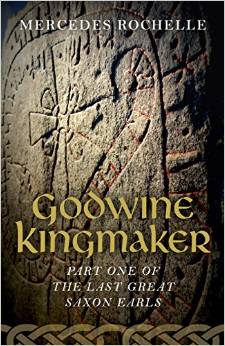Adventures in (Historical Novel) Research: The Battle of Hastings did not take place at Hastings

Mercedes Rochelle will be an exhibiting author at the Gaithersburg Book Festival on May 16. She has written two books of historical fiction (“Heir to a Prophecy” and “Godwine Kingmaker”) about 11th century Britain. Mercedes learned about living history as a re-enactor and has been enamored with historical fiction ever since. She lives in Sergeantsville, NJ, with her husband, in a log home they built themselves.
Below, Mercedes shares a story from her experiences conducting research for “Heir to a Prophecy.”
On my first trip to England, I was terribly excited to tour the battlefield of Hastings, and we headed to the town of that name in our rented car. This was in the early ’90s, before the internet. I had all my sketches of the battle itself, but I was kind of unclear as to exactly where it was fought. I figured I’d see signs pointing the way, or something… actually, I’m not sure just what I expected to find! What I didn’t expect was to find the town of Hastings, and no mention of a battlefield anywhere. What a panic!
Luckily, Brits and Americans DO share a common language, and a kind soul pointed us in the right direction. We eventually found our way to Battle, a little over 6 miles to the northwest of Hastings. Needless to say, it’s called Battle for a reason! There is an abbey ruin on the site, aptly named Battle Abbey, the altar of which was built on the very spot that Harold Godwineson was killed. And behind the abbey we found the battlefield, appropriately marked with signboards depicting the stages of the battle.
When Duke William landed his fleet on the shores of Britain, he chose the bay of Pevensey, which was a welcoming haven with an old Roman fort, improved by Harold Godwineson and just recently emptied when the Saxon army marched north to Stamfordbridge. Intending to alarm the Saxons as well as live off the land, William marched his army east, laying waste all the way to Hastings,  where he erected one of his portable fortifications near the little harbor. From there, he progressed northward toward Senlac hill, where he met the exhausted but triumphant Saxons in their last stand.
where he erected one of his portable fortifications near the little harbor. From there, he progressed northward toward Senlac hill, where he met the exhausted but triumphant Saxons in their last stand.
Why is it called the battle of Hastings? Well, as recently as the 19th century it was referred to as the Battle of Senlac; apparently, the venerable historian Edward A. Freeman created quite a controversy by using (or inventing?) this name. The town of Battle would have been built around the abbey, so it didn’t exist in 1066; Hastings was probably the closest village to the battlefield.


